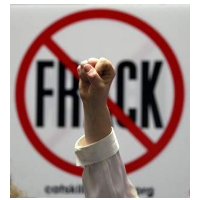L.A. Is Set to Become the Largest U.S. City to Ban Fracking and Acidization
 (photo: Mike Groll, Associated Press)
(photo: Mike Groll, Associated Press)
If the ordinance ordered drafted by the Los Angeles City Council Friday reflects the fervor of the audience and words of the politicians, L.A. may become the largest city in the U.S. to ban hydraulic fracturing (fracking) and acidization of oil and gas wells.
The council unanimously directed City Attorney Mike Feuer’s office to write an ordinance that would change the zoning code to ban the practice of well “stimulation” until the council is convinced that state and federal regulations protect residents and drilling is in compliance with the Clean Air Act, the Clean Water Act and the Safe Drinking Water Act.
“I think we all can agree unregulated fracking is crazy,” Councilman Paul Koretz, one of the authors of the motion, said before the vote. Councilman and co-author Mike Bonin said, “This does not meet any test of common sense or public safety.”
Well, fracking meets at least one test: it has been approved as “safe and effective” by the oil and gas industry. The Western States Petroleum Assn., the industry’s lobbying arm, says on its website:
“Hydraulic fracturing has never been shown to adversely impact the state’s environment, drinking water supply or pose any risk to nearby residents. In fact, to date there has not been a documented case of fluids used in fracturing operations entering a drinking water aquifer.”
Fracking injects thousands of gallons of pressurized water, sand and toxic chemicals into the ground to crack open wells. Acidization shoots large amounts of hydrochloric or hydrofluoric acid into them to dissolve rock formations and allow easier access to gas and oil. Fracking has been linked to groundwater contamination, air pollution, releases of methane gas, micro-earthquakes and sinkholes.
Although fracking has been used in a limited fashion across the country for decades, it has only recently been receiving attention as energy companies attempt to reinvigorate depleted oil and gas wells using new technology. Los Angeles does not have a lot of active sites but it has the potential for growth. There are 1,880 active and 2,932 abandoned oil and gas wells, according to the state Department of Conservation.
An analysis by the Los Angeles Times of data from the South Coast Air Quality Management District (AQMD) found 218 wells in the county using “stimulation” methods since last summer, but only 17 of those are in the city.
The data relies on self-reporting by oil and gas companies, which is indicative of the lack of government oversight that has critics upset. California did not regulate fracking until last year, when lawmakers passed Senate Bill 4.
To the dismay of many of its original supporters—many of whom would have preferred a moratorium—the law allows fracking to continue unabated until 2015 while regulations are drafted. A mandated statewide environmental impact report on the practice isn’t due until July 2015. And while the law does require frackers to reveal what toxic materials they inject into the ground, they can keep secret details on the mix of the toxic brew. Critics complain that public notification provisions are ineffectively weak.
The Western States Petroleum Assn. approved of the final bill.
–Ken Broder
To Learn More:
Los Angeles Moves Forward With Fracking Ban (by Dakota Smith, Los Angeles Daily News)
LA City Council Moves Forward with Effort to Ban Fracking (by Alice Walton, KPCC)
L.A. City Council Moves Toward Fracking Ban (by Emily Alpert Reyes, Los Angeles Times)
Los Angeles Becomes Largest City to Approve Fracking Moratorium (by Carol Linnitt, desmogblog.com)
Los Angeles Bans Fracking (by Parimal Rohit, Westside Today)
Activists Urge L.A. City Council to Ban Fracking and Acidizing (by Emily Alpert Reyes, Los Angeles Times)
List of Bans Worldwide (Keep Tap Water Safe)
Lawmakers OK Fracking Legislation with Giant Loopholes (by Ken Broder, AllGov California)
- Top Stories
- Controversies
- Where is the Money Going?
- California and the Nation
- Appointments and Resignations
- Unusual News
- Latest News
- California Forbids U.S. Immigration Agents from Pretending to be Police
- California Lawmakers Urged to Strip “Self-Dealing” Tax Board of Its Duties
- Big Oil’s Grip on California
- Santa Cruz Police See Homeland Security Betrayal in Use of Gang Roundup as Cover for Immigration Raid
- Oil Companies Face Deadline to Stop Polluting California Groundwater





